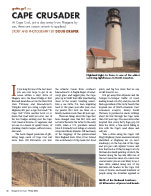
cape crusader
By Doug Draper

cape crusader
By Doug Draper
If you long for one of the best views you can ever hope to get of an ocean within a day’s drive of Niagara, cross the Peace Bridge at Fort Erie and head due east on the New York State Thruway and Massachusetts Turnpike until you swing a right onto Highway 495 past a sign that reads “To Cape Cod.” Drive another hour or so down that road until you cross one of the two bridges arching over the Cape Cod Canal at Bourne or Sagamore and you are in a haven of quaint towns, of spiraling church steeples, saltbox houses, and sand.
The hook-shaped peninsula of glittering beige sands of Cape Cod curl more than 100 kilometres out into the Atlantic Ocean from southeast Massachusetts. A fragile finger of wind-swept grass and ragged pine, the Cape piles up in bluffs that offer breathtaking views of the ocean’s breaking waters. Like a sea turtle, I’ve been migrating back to this place year after year, since my parents first took me there on a family vacation more than 40 years ago.
There are things about the Cape that have changed since that first visit, and not all of them for the better. In the early 1960s, when a U.S. president named John F. Kennedy took refuge at a family compound there, Hyannis still had many of the trappings of the quintessential New England town. Now, it has turned into a mishmash of strip malls, fast-food joints, and big box stores that no one would travel to see.
But get away from Hyannis and the bumper-to-bumper traffic of roads leading in and out of it, and you can still find a good deal of the rustic beauty that inspired one of North America’s most renowned essayists, Henry David Thoreau, to produce his classic writings about his trek through the Cape more than 150 years ago. You encounter what inspired that corny Patty Page pop hit from the 1950s, a tune about falling in love with the Cape’s sand dunes and salty air.
Take a drive along the Cape’s Old King’s Highway (more unceremoniously identified as Highway 6A on most roadmaps) on the bay side of the Cape and you pass old captains’ houses and inns that look as if they’ve leapt out of a Norman Rockwell painting. At dusk, the beaches along the bay side offer one of the most awesome views of a sunset over coastal waters you are ever likely to see. I have often walked along one of my favourite old beaches in the Cape Cod town of Dennis and heard hundreds of people along the shoreline applaud at the end of a sunset, as if they had just experienced the end of a stirring opera.
The many beautiful inns of Cape Cod, with history echoing off their walls and rafters, liberate visitors from nondescript chain hotels. Our family’s favourite is the Old Sea Pines Inn in the bayside town of Brewster. Old Sea Pines was an early-1900s finishing school for girls that has been lovingly restored by Steve and Michele Rowan, two upstate New Yorkers who fell so in love with the Cape when they were young, they moved there. In the cozy commons room of the Old Sea Pines Inn, members of my family and I have, over the years, met many interesting people from all over the world. Here we are a short drive away from some of the most beautiful towns on the Cape, including Orleans, Harwich, and Chatham, and some of the nicest vistas of both the bay and ocean. Check out Nauset Beach along the ocean side of Orleans as an example of a New England shoreline tailor-made for any Hollywood script set in the region.
Further out on the Cape, through the towns of Eastham, Wellfleet, Truro, and Provincetown, you can stroll more than 60 kilometres of pristine beach preserved forever, thanks to the vision of the Sierra Club and the late President Kennedy, as the “National Seashore.” Here you will find the Highland Light, one of the oldest surviving lighthouses in North America, and the one that is featured in Thoreau’s Cape Cod essays. Much of this shoreline is about as natural as it was when the pilgrims of Mayflower fame passed by it on their way to nearby Plymouth 384 years ago.
And what can one say about Provincetown at the outermost tip of Cape Cod? This former whaling and smuggling hub turned resort and artists’ colony has been a Mecca for bohemians for more than 100 years. Great political commentators such as John Reed (who wrote Ten Days That Shook the World, the seminal book on the Russian Revolution), and great playwrights like Eugene O’Neill, frequently migrated here for inspiration during the early decades of the last century. Not too long ago, my wife Mary and I passed Norman Mailer, the Pulitzer Prize-winning author who still lives there, walking along the main street. Take a walk out on the main wharf, in season, and, for about half the price of going to an amusement park featuring marine mammals performing tricks in tanks, board one of the vessels of the Dolphin Fleet and spend four hours out on the open seas, experiencing the wonder of whales in the wild. Once you’ve seen these magnificent giants there, you will never want to see them in an artificial tank again.
As possibly the quickest trip from Niagara to the ocean by car, Cape Cod has so much to offer someone looking for an escape from the routine stresses of life. I’ve had no trouble finding peace of mind walking along one of the beaches there. I’m sure you can too.